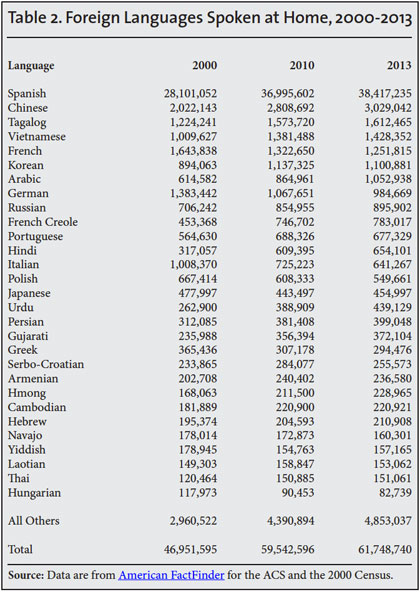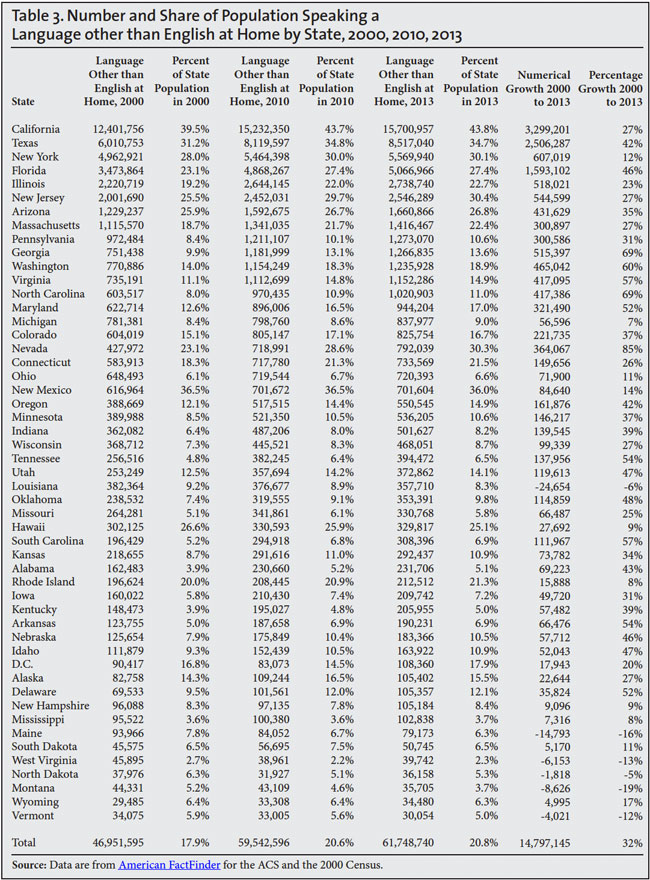Download a PDF of this Backgrounder
Steven A. Camarota is the Director of Research and Karen Zeigler is a demographer at the Center for Immigration Studies.

The Census Bureau recently released data from the 2013 American Community Survey (ACS), including languages spoken for those five years of age and older. The new data show that the number of people who speak a language other than English at home reached an all-time high of 61.8 million, up 2.2 million since 2010. The largest increases from 2010 to 2013 were for speakers of Spanish, Chinese, and Arabic. One in five U.S. residents now speaks a foreign language at home.
Among the findings:
- In 2013, a record 61.8 million U.S. residents (native-born, legal immigrants, and illegal immigrants) spoke a language other than English at home.
- The number of foreign-language speakers increased 2.2 million between 2010 and 2013. It has grown by nearly 15 million (32 percent) since 2000 and by almost 30 million since 1990 (94 percent).
- The largest increases 2010 to 2013 were for speakers of Spanish (up 1.4 million, 4 percent growth), Chinese (up 220,000, 8 percent growth), Arabic (up 188,000, 22 percent growth), and Urdu (up 50,000, 13 percent growth). Urdu is the national language of Pakistan.
- Languages with more than a million speakers in 2013 were Spanish (38.4 million), Chinese (three million), Tagalog (1.6 million), Vietnamese (1.4 million), French (1.3 million), and Korean and Arabic (1.1 million each). Tagalog is the national language of the Philippines.
- The percentage of the U.S. population speaking a language other than English at home was 21 percent in 2013, a slight increase over 2010. In 2000, the share was 18 percent; in 1990 it was 14 percent; it was 11 percent in 1980.
- Of the school-age (5 to 17) nationally, more than one in five speaks a foreign language at home. It is 44 percent in California and roughly one in three students in Texas, Nevada, and New York. But more surprisingly, it is now one in seven students in Georgia, North Carolina, Virginia, Nebraska and Delaware; and one out of eight students in Kansas, Utah, Minnesota, and Idaho.
- Many of those who speak a foreign language at home are not immigrants. Of the nearly 62 million foreign-language speakers, 44 percent (27.2 million) were born in the United States.1
- Of those who speak a foreign language at home, 25.1 million (41 percent) told the Census Bureau that they speak English less than very well.
- States with the largest share of foreign-language speakers in 2013 include: California, 45 percent; New Mexico, 36 percent; Texas 35 percent; New Jersey, 30 percent; Nevada, 30 percent; New York, 30 percent; Florida, 27 percent; Arizona, 27 percent; Hawaii, 25 percent; Illinois, 23 percent; Massachusetts, 22 percent; Connecticut, 22 percent; and Rhode Island, 21 percent.
- States with the largest percentage increases in foreign-language speakers 2010 to 2013 were: North Dakota, up 13 percent; Oklahoma, up 11 percent; Nevada, up 10 percent; New Hampshire, up 8 percent; Idaho, up 8 percent; Georgia, up 7 percent; Washington, up 7 percent; Oregon, up 6 percent; Massachusetts, up 6 percent; Kentucky, up 6 percent; Maryland, up 5 percent; and North Carolina, up 5 percent.
- Taking a longer view, states with the largest percentage increase in foreign-language speakers 2000 to 2013 were: Nevada, up 85 percent; North Carolina, up 69 percent; Georgia, up 69 percent; Washington, up 60 percent; South Carolina, up 57 percent; Virginia, up 57 percent; Tennessee, up 54 percent; Arkansas, up 54 percent; Maryland, up 52 percent; Delaware, up 52 percent; Oklahoma, up 48 percent; Utah, up 47 percent; Idaho, up 47 percent; Nebraska, up 46 percent; Florida, up 46 percent; Alabama, up 43 percent; Texas, up 42 percent; Oregon, up 42 percent; and Kentucky, up 39 percent.
Data Source. On September 18, the Census Bureau released some of the data from the 2013 ACS. The survey reflects the U.S. population as of July 1, 2013. The ACS is by far the largest survey taken by the federal government each year and includes over two million households.2 The Census Bureau has posted some of the results from the ACS to American FactFinder.3 It has not released the public-use version of the ACS for researchers to download and analyze. However a good deal of information can be found at FactFinder. Unless otherwise indicated, the information in this analysis comes directly from FactFinder.
There are three language questions in the ACS for 2010 and 2013. The first asks whether each person in the survey speaks a language other than English at home. The second, for those who answer "yes", asks what language the person speaks at home. The third asks how well the person speaks English. Only those who speak a language at home other than English are asked about their English skills. The 1980, 1990, and 2000 decennial censuses (long form) asked almost the exact same questions.
In this Backgrounder we report some statistics for the immigrant population, referred to as the foreign-born by the Census Bureau. The foreign-born are comprised of those individuals who were not U.S. citizens at birth. They include naturalized citizens, legal permanent residents (green card holders), temporary workers, and foreign students. They do not include those born to immigrants in the United States, including to illegal immigrant parents, nor do they include those born in outlying U.S. territories, such as Puerto Rico. Prior research by the Department of Homeland Security and others indicates that some 90 percent of illegal immigrants respond to the ACS.4




End Notes
1 Of the native-born who speak a language other than English at home, 9.9 million (36 percent) are 17 and under; the remaining 64 percent were born in the United States and are adults who speak a language other than English at home.
2 Detailed information on the survey methodology, questions, and other information on the American Community Survey can be found here.
3 FactFinder can be found here.
4 The Department of Homeland Security uses the ACS as the basis for its estimates of the illegal immigrant population. See the most recent iteration of the unauthorized immigrant population, "Estimates of the Unauthorized Immigrant Population Residing in the United States: January 2012".
